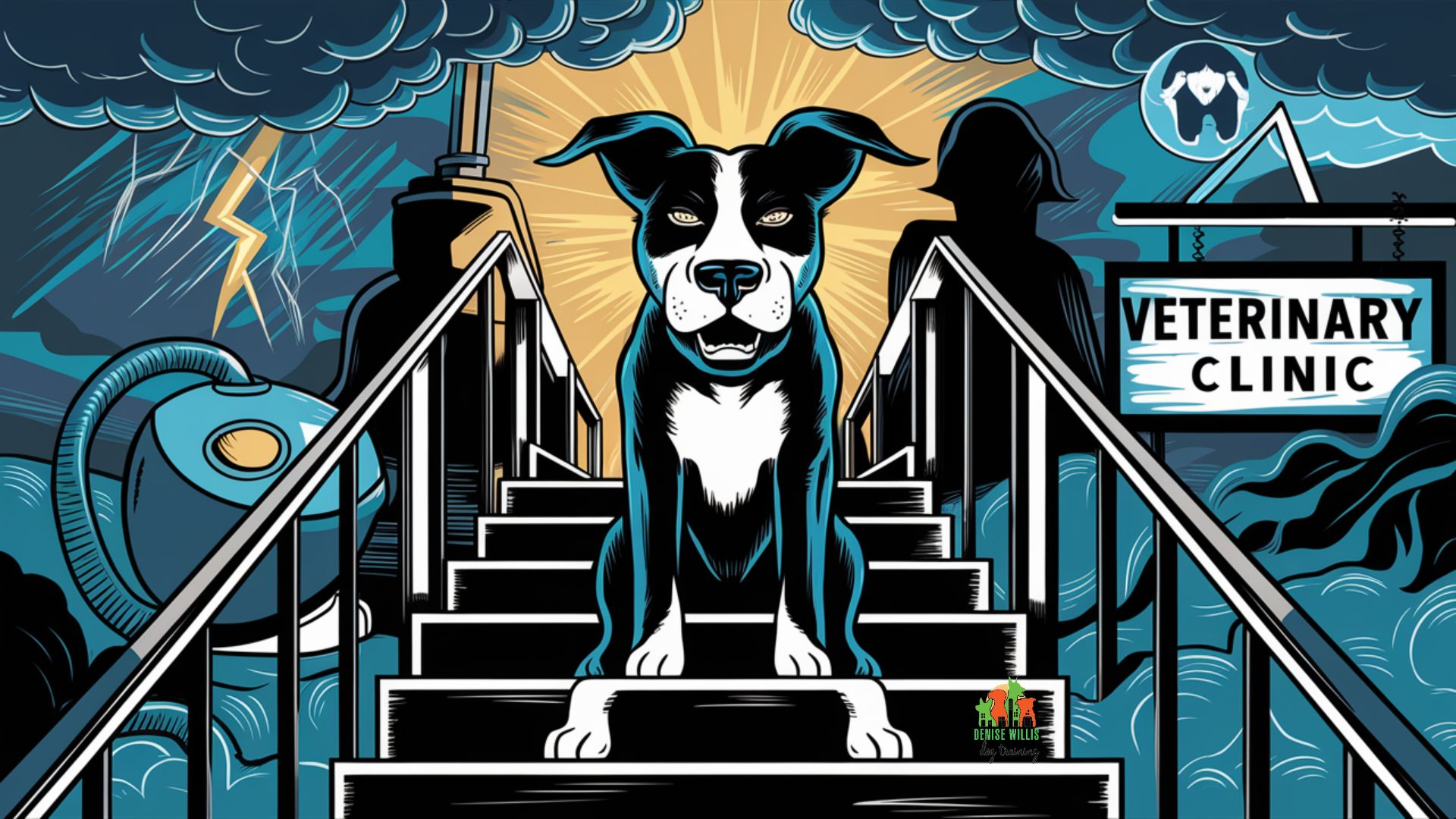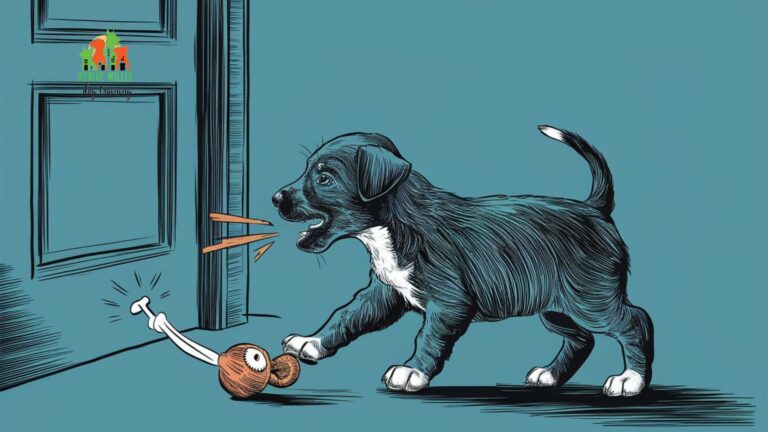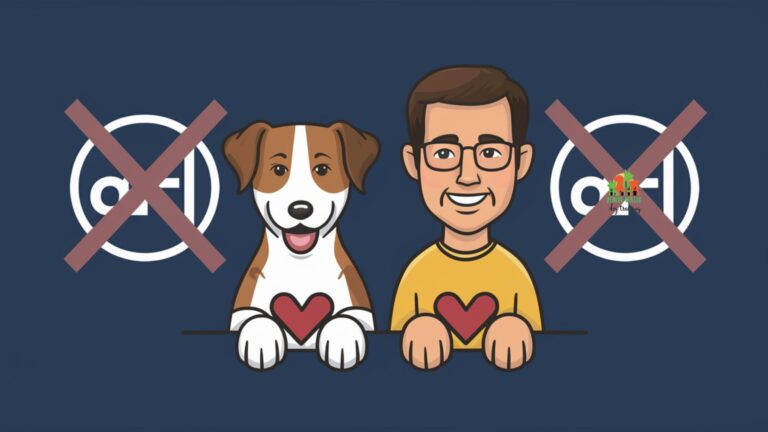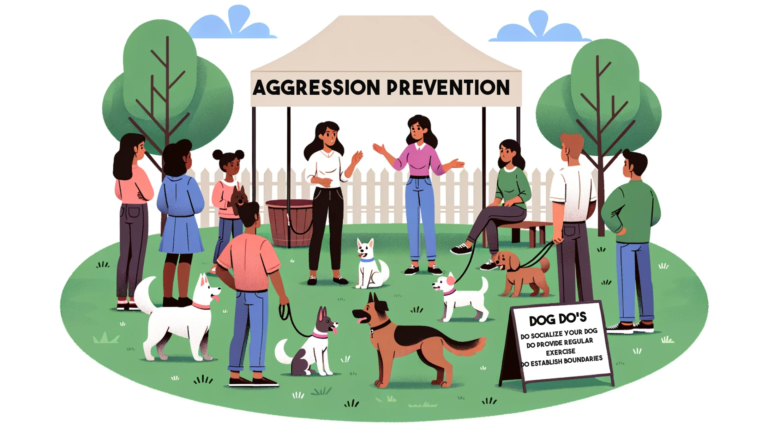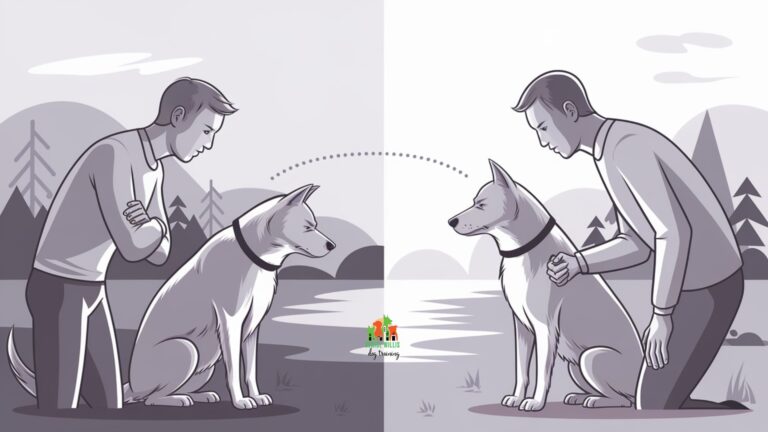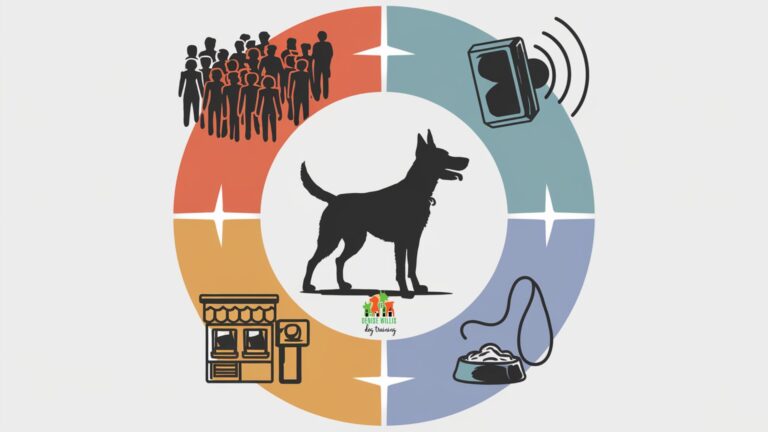How to Help Your Scaredy-Dog: 6 Common Dog Phobias and Their Solutions
📍 Service Area Notice: DW Dog Training provides in-person training services exclusively in the Greater Baltimore area. While our blog content is designed to help dog owners internationally, our hands-on training services are locally focused. For readers outside our service area, we hope you find value in our articles and welcome you to reach out with questions!
Is your dog phobic about everyday situations?
Picture this: It’s a beautiful day, perfect for a walk. You’ve got the leash, treats in your pocket, ready to go.
But your dog takes one look outside and bolts under the bed. Sound familiar?
As a professional dog trainer with over two decades of experience, I’ve seen my share of scaredy-dogs.
From tiny Chihuahuas afraid of shadows to gentle giants trembling at squeaky toys, I’ve helped countless pups overcome their fears.
Grab a drink, settle in, and let’s talk about transforming your nervous Nellie into a confident canine.
Common Dog Phobias and Solutions
Noise Phobias
Create a safe space and gradually desensitize your dog to loud noises.
Separation Anxiety
Practice short absences and provide engaging toys when you’re away.
Fear of Strangers
Use controlled exposure and positive reinforcement to build confidence.
Veterinarian Visits
Practice vet visits without exams and use calming aids when needed.
Key Takeaways
Before we dive into the nitty-gritty, here are the main points we’ll be covering:
- Dog phobias are common and can develop at any age.
- The six most common phobias in dogs are fear of loud noises, separation anxiety, fear of strangers, fear of veterinarians, fear of specific objects, and fear of stairs.
- Each phobia has unique symptoms, causes, and solutions.
- Positive reinforcement and patience are key in helping dogs overcome their fears.
- Creating a safe environment and understanding your dog’s body language are crucial.
- Professional help may be necessary for severe cases of phobia.
- With the right approach, most dogs can learn to manage their fears and lead happier lives.
Understanding Dog Phobias
Alright, let’s get down to business. What exactly is a dog phobia? Simply put, it’s an intense, irrational fear of a specific object, situation, or circumstance. It’s more than just a mild dislike or momentary startle – we’re talking full-blown panic mode here.
Now, you might be thinking, “But my dog is afraid of the vacuum cleaner. Isn’t that rational? That thing is loud and scary!” Fair point. But here’s the difference: a normal fear response is proportional to the threat and subsides when the threat is gone. A phobia, on the other hand, is an exaggerated fear response that persists even when the perceived threat isn’t present.
So, why do our furry friends develop these intense fears? Well, like many things in life, it’s complicated. Phobias can stem from a variety of sources:
- Lack of early socialization
- Traumatic experiences
- Genetics
- Medical conditions
- Even seemingly random associations
The tricky part is that sometimes, we might never know exactly why our dog developed a particular phobia. But don’t worry – understanding the ‘why’ isn’t always necessary to help our pups overcome their fears.
Now that we’ve got the basics down, let’s dive into the six most common phobias I’ve encountered in my years as a dog trainer. Buckle up, folks – we’re about to go on a wild ride through the canine psyche!

6 Common Dog Phobias and Their Solutions
1. Fear of Loud Noises (Fireworks and Thunder)
Ah, the classic noise phobia. If your dog turns into a quivering mess at the first rumble of thunder or pop of a firework, you’re not alone. This is one of the most common phobias I see in my work.
Symptoms:
- Trembling or shaking
- Hiding in small spaces
- Excessive panting
- Destructive behavior
- Loss of bladder or bowel control
Causes:
- Lack of exposure during critical developmental periods
- Genetic predisposition (some breeds are more sensitive to noise)
- Past traumatic experiences
Solutions:
- Create a safe space: Set up a cozy den-like area where your dog can retreat during noisy events.
- Desensitization: Gradually expose your dog to recorded sounds at a low volume, rewarding calm behavior.
- Counter-conditioning: Pair scary noises with positive experiences like treats or play.
- Consider anxiety wraps or pheromone products for added comfort.
- In severe cases, consult your vet about anti-anxiety medications.
Remember, patience is key here. Rome wasn’t built in a day, and your dog won’t overcome their fear of fireworks overnight. But with consistent effort, you can help your pup weather the storm (pun intended).
2. Separation Anxiety
If your dog turns into a furry tornado of destruction every time you leave the house, you might be dealing with separation anxiety. This phobia can be particularly challenging for both dogs and their humans.
Symptoms:
- Excessive barking or howling when left alone
- Destructive behavior, especially around exit points
- Inappropriate elimination (even in housetrained dogs)
- Excessive drooling or panting
- Attempts to escape
Causes:
- Sudden changes in routine or family structure
- Lack of proper alone-time training as a puppy
- Past experiences of abandonment
- Certain breeds may be more prone to anxiety
Solutions:
- Gradual desensitization to your departure cues (like picking up keys or putting on shoes)
- Practice short absences, gradually increasing duration
- Provide engaging toys or puzzles to keep your dog occupied while you’re gone
- Consider crate training as a way to create a safe, comforting space
- Don’t make a big fuss about leaving or returning home
Pro tip: A tired dog is a good dog. A nice long walk or play session before you leave can work wonders!
3. Fear of Strangers
Some dogs never got the memo that strangers are just friends they haven’t met yet. If your pup turns into Cujo at the sight of an unfamiliar face, you’re likely dealing with a fear of strangers.
Symptoms:
- Excessive barking or growling at unfamiliar people
- Cowering or hiding when visitors arrive
- Aggressive displays like lunging or snapping
- Trembling or shaking in the presence of strangers
- Avoidance behaviors like turning away or refusing to approach
Causes:
- Lack of socialization during critical developmental periods
- Past negative experiences with unfamiliar people
- Genetic predisposition in some breeds
- Lack of exposure to diverse types of people
Solutions:
- Controlled exposure: Start with strangers at a distance and gradually decrease the distance as your dog becomes more comfortable
- Use positive reinforcement: Reward calm behavior around strangers with high-value treats
- Teach alternative behaviors: Train your dog to sit or look at you when they see a stranger
- Never force interactions: Let your dog approach strangers on their own terms
- Enlist the help of patient friends to practice with
Remember, “stranger danger” is a real thing for some dogs. Your job is to show them that new people can be a source of good things, not a threat.
4. Fear of the Veterinarian
If your dog starts shaking like a leaf as soon as you pull into the vet’s parking lot, you’re not alone. Many dogs develop a fear of the veterinarian, and honestly, can we blame them? Strange smells, unfamiliar handling, and sometimes discomfort or pain – it’s no wonder some pups aren’t fans of these visits.
Symptoms:
- Trembling or shaking at the vet’s office
- Attempting to flee or hide
- Aggressive behaviors like growling or snapping
- Excessive drooling or panting
- Refusing to enter the clinic or exam room
Causes:
- Past negative experiences at the vet
- Association of the vet with pain or discomfort
- Lack of positive experiences in medical settings
- General fear of unfamiliar environments or handling
Solutions:
- Practice vet visits: Take your dog to the vet’s office just for treats and pets, no exams involved
- Handle your dog at home: Get them used to being touched all over their body in a positive way
- Use calming aids: Consider pheromone sprays or anti-anxiety wraps for vet visits
- Find a fear-free certified vet: These professionals are trained in reducing stress for pets
- Be calm yourself: Dogs pick up on our emotions, so stay relaxed during vet visits
Pro tip: Always bring high-value treats to the vet. Nothing says “this place isn’t so bad” like a steady stream of bacon bits!
5. Fear of Specific Objects (e.g., Vacuum Cleaners)
Ever seen a dog go into full-on battle mode with a harmless household object? Whether it’s the vacuum cleaner, the hairdryer, or that one creepy garden gnome, some dogs develop intense fears of specific items.
Symptoms:
- Barking or growling at the object
- Attempting to attack the object
- Hiding or fleeing when the object appears
- Refusing to enter rooms where the object is present
- Showing signs of stress like whale eye or lip licking when near the object
Causes:
- Sudden or loud noises associated with the object
- Unpredictable movements (like a fluttering trash bag)
- Past negative experiences with similar objects
- Lack of exposure during critical developmental periods
Solutions:
- Gradual exposure: Start with the feared object at a distance or turned off
- Positive associations: Pair the presence of the object with treats or play
- Desensitization: Slowly get your dog used to the sight, sound, and movement of the object
- Never force interaction: Let your dog approach the object on their own terms
- Consider a “this is how we do it” approach: Show your dog that you can interact with the object safely
Remember, what seems silly to us can be genuinely terrifying to our dogs. Always take their fears seriously, even if the source seems harmless to human eyes.
6. Fear of Going Up or Down Stairs
Last but not least, we have the stair-phobic pup. Whether it’s a fear of going up, down, or both, this phobia can seriously limit your dog’s mobility and quality of life.
Symptoms:
- Refusing to approach stairs
- Trembling or freezing at the top or bottom of staircases
- Attempting to turn back when placed on stairs
- Whining or barking when near stairs
- Showing stress signals like yawning or lip licking around stairs
Causes:
- Lack of exposure to stairs during critical developmental periods
- Past negative experiences on stairs (like slipping or falling)
- Poor depth perception or vision issues
- Pain or physical discomfort (especially in older dogs)
Solutions:
- Start small: Use a low platform or single step to build confidence
- Use a leash for guidance and support
- Lure with high-value treats, placing them on each step
- Practice on different types of stairs to generalize the skill
- Consider non-slip mats or runners for slippery stairs
Pro tip: For small dogs or those with mobility issues, consider installing ramps as an alternative to stairs in your home.
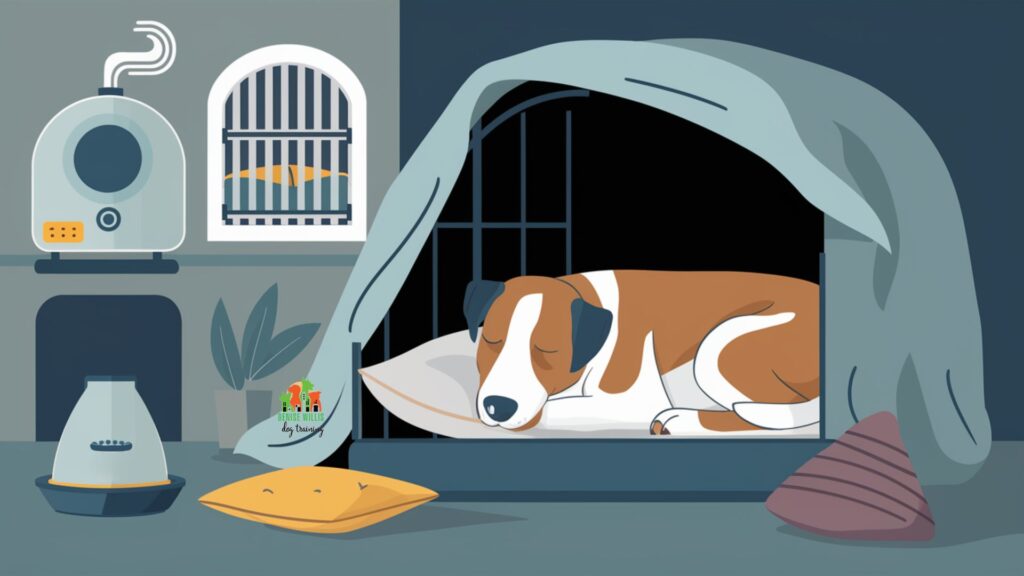
General Tips for Helping Dogs with Phobias
Now that we’ve covered the most common phobias, let’s talk about some general strategies that can help with any fear your furry friend might be facing.
- Patience is key: Rome wasn’t built in a day, and your dog won’t overcome their fears overnight. Be prepared for a gradual process.
- Never punish fear: Yelling at or punishing your dog for showing fear will only make things worse. Instead, focus on rewarding calm, brave behavior.
- Lead by example: Dogs are masters at reading our emotions. Stay calm and confident to help your dog feel secure.
- Create a safe haven: Every dog should have a quiet, comfortable space where they can retreat when feeling overwhelmed.
- Use positive reinforcement: Treats, praise, and play can go a long way in helping your dog form positive associations with scary things.
- Respect your dog’s limits: Pushing your dog too far too fast can backfire. Always work at your dog’s pace.
- Consider professional help: If you’re struggling to make progress, don’t hesitate to reach out to a certified dog trainer or behaviorist.
Remember, every dog is unique. What works for one might not work for another, so be prepared to adapt your approach as needed.
Timeline of Phobia Development in Dogs
Understanding when and how phobias can develop in dogs is crucial for prevention and effective management. Just like humans, our canine companions go through various life stages, each with its own potential for developing fears and anxieties. Let’s take a journey through a dog’s life to explore the key periods where phobias may emerge and how we can help our furry friends navigate these challenges.
Timeline of Phobia Development in Dogs
Puppy Stage (8-16 weeks)
Critical socialization period. Positive experiences prevent phobias, while negative ones can have lasting effects.
Adolescence to Early Adulthood
Second fear period (6-14 months). New fears may appear suddenly. Consistent training is crucial.
Adulthood
Most stable period, but new phobias can still develop. Traumatic experiences may lead to sudden onset of fears.
Senior Years
Changes in vision or hearing, cognitive decline, and pain can lead to new anxieties or phobic behaviors.
As we can see, the potential for developing phobias exists throughout a dog’s life. However, it’s important to remember that with proper care, socialization, and training, many of these fears can be prevented or managed effectively. Even if your dog has already developed a phobia, it’s never too late to start working on overcoming their fears. Whether you’re dealing with a nervous puppy or a senior dog with new anxieties, there’s always hope for improvement with patience, understanding, and the right approach. By being aware of these critical periods, we can better support our dogs and help them lead happier, more confident lives.
Frequently Asked Questions About Phobias in Dogs
Let’s tackle some of the most common questions I get about dog phobias:
Q: Can dogs have phobias? A: Absolutely! Dogs, like humans, can develop intense, irrational fears of specific objects, situations, or circumstances. These phobias can significantly impact their quality of life if not addressed.
Q: What is an example of a dog phobia? A: One common example is astraphobia, or fear of thunderstorms. Dogs with this phobia may show extreme anxiety, try to hide, or even become destructive during storms.
Q: What is extreme fear in dogs? A: Extreme fear in dogs goes beyond normal caution. It can manifest as panic attacks, complete shutdowns, or aggressive behavior. Signs include excessive panting, drooling, shaking, attempting to escape, or losing control of bladders or bowels.
Q: What are dogs commonly afraid of? A: While individual dogs can fear almost anything, common fears include loud noises (like fireworks or thunder), strangers, other dogs, veterinary visits, and specific objects like vacuum cleaners.
Recommended Products for Managing Dog Phobias
While addressing phobias primarily involves training and behavior modification, certain products can support your efforts:
- ThunderShirt Classic Dog Anxiety Jacket: This pressure wrap can help calm anxious dogs during stressful situations.
- ADAPTIL Calm Home Diffuser: This releases calming pheromones that can help reduce anxiety in dogs.
- PetSafe Gentle Leader Head Collar: This can provide better control during walks, which can be helpful for dogs with fear of strangers or other dogs.
- Zesty Paws Calming Bites: These natural supplements may help reduce anxiety in some dogs.
- Smart Pet Love Snuggle Puppy Behavioral Aid Toy: This plush toy with a heartbeat can provide comfort, especially for puppies or dogs with separation anxiety.
Remember, these products are aids in training and management, not solutions on their own. Always use them in conjunction with proper training techniques.
Further Reading
Want to dive deeper into understanding and helping your furry friend? Check out these related articles:
- 5 Proven Strategies to Stop Your Dog’s Aggression Towards Other Dogs: This article provides practical tips for managing dog-to-dog aggression, which can sometimes stem from fear.
- Decoding Your Dog: 15 Body Language Signals You Need to Know: Understanding canine body language is crucial in identifying signs of fear and anxiety in your dog.
- The Shy Dog’s Guide to Conquering Fear: 10 Simple Techniques: This guide offers additional strategies for helping fearful dogs gain confidence.
- 7 Surprising Signs Your Dog Has Separation Anxiety: Dive deeper into understanding and addressing separation anxiety in dogs.
- Dog Aggression Solutions: A Complete Guide to Stopping Aggressive Behavior in Dogs: This comprehensive guide explores various types of dog aggression, including fear-based aggression, and their solutions.
Test Your Canine Knowledge: The Great Dog Phobia Quiz
Alright, dog lovers, it’s time to put your newfound knowledge to the test! You’ve journeyed with me through the wild world of canine fears, from thunder-phobic pooches to stair-scared schnauzers. Now, let’s see how much of that information stuck in your noggin.
Don’t worry, this isn’t a pop quiz from your dreaded high school days. Think of it more as a fun challenge to flex those dog-savvy muscles you’ve been building. Whether you ace it or fumble a bit, remember: every bit of learning brings you one step closer to being the best pet parent you can be.
So, grab a treat (for yourself, not your dog – though they probably deserve one too), get comfy, and let’s dive into this tail-wagging test of your canine comprehension. Ready to fetch some knowledge? Let’s go!
Dog Phobias Quiz
Whew! You made it through the quiz – give yourself a pat on the back (or a belly rub, if that's more your style). How'd you do? Whether you aced it like a professional dog whisperer or stumbled a bit like a clumsy puppy, remember: the goal here is learning, not perfection.
Every question you pondered is another tool in your kit for understanding and helping our furry friends. And let's be honest, if we've learned anything about dogs, it's that they don't judge us based on our quiz scores. They're just happy we're trying to understand them better.
Final Thoughts
Whew! We've been on quite a journey, haven't we? From thunder-phobic pooches to stair-scared schnauzers, we've covered a lot of ground. But here's the thing, fellow dog lovers: knowledge is power. By understanding these common phobias and how to address them, you're already taking a huge step towards helping your furry friend live their best life.
Remember, dealing with a phobic dog isn't always a walk in the park (sometimes literally!). It takes time, patience, and a whole lot of love. But trust me, the moment you see your once-terrified terrier confidently strut past that scary vacuum cleaner, or your formerly anxious Aussie calmly watching fireworks from the window – well, that's a feeling that can't be beat.
Here's the most important thing I want you to take away from all this: there's hope. No matter how deep-seated your dog's fears might seem, with the right approach and a little help, most dogs can learn to manage their phobias and lead happier, more confident lives.
Now, I'd love to hear from you. Have you dealt with any of these phobias in your own dogs?
What strategies worked for you?
What challenges did you face?
Your story could be the beacon of hope that another struggling dog owner needs right now.
And hey, if you're feeling overwhelmed or unsure about how to address your dog's phobias, don't hesitate to reach out for professional help. At DW Dog Training, we've been helping dogs (and their humans) overcome fears and phobias for years. We use science-based, positive methods to address a wide range of behavior issues – no dominance nonsense required.
Ready to help your scaredy-dog become a confident canine? Contact us to learn more about our services or to schedule a consultation. Let's work together to create a happier, more harmonious life for you and your four-legged friend.
So, what's been your biggest challenge in helping your dog overcome their fears? Have you tried any of the techniques we discussed? What worked, and what didn't? Share your thoughts and experiences in the comments – let's learn from each other and create a community of support for our phobic pooches!
Remember, every step forward, no matter how small, is progress. You've got this, and your dog is lucky to have such a dedicated, caring owner. Here's to wagging tails, happy barks, and fear-free adventures in your future!

